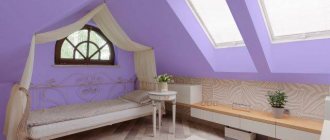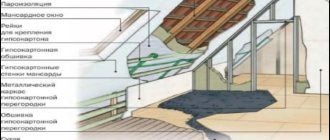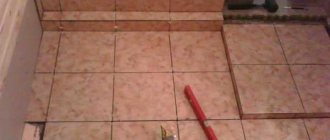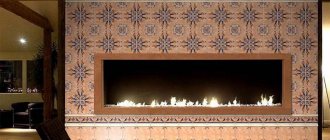The use of thermal insulation materials for stoves has several goals: to ensure fire safety and reduce heat loss . The latter option is most often used in the construction of fireplaces, since in this case it is necessary to create a directed flow of heat, and not to warm up the entire stove mass. When carrying out work, it is recommended to use existing standards to avoid mistakes and prevent the risk of fire in building structures.
Materials for thermal insulation of fireplaces
Special thermal insulation for fireplaces is used to minimize heat loss in all parts of the fireplace: the chimney, the stove mass and the firebox itself. This allows you to increase the efficiency of heating equipment. Insulation of different parts of the fireplace has the following goals:
- Protects the chimney from the destructive effects of condensation that forms during a sudden change in temperature. The aggressive effect of condensate is due to the moisture content, various acids formed during combustion and carbon dioxide.
- Where the pipe passes through the ceiling, special care should be taken to comply with fire safety standards. If wooden building materials are used, special care should be taken to protect the surface of the ceiling.
- High-temperature insulation in fireplaces is used to create a directed flow of thermal energy to warm people sitting across from it. For these purposes, infrared reflectors are used, which are installed in the firebox itself.
- Protection of wall structures using a heat-protective layer. Otherwise, a brick wall can quickly become unusable due to a sharp temperature change, and a wooden wall can catch fire.
The building materials used for thermal insulation of the fireplace are represented by the following groups:
- containing stone fibers (Rockwool, TEXHO T80, PAROC FPS 17) – are produced in the form of slabs and have a foil coating on one of their sides, which allows them to withstand temperatures of several thousand degrees;
- based on silica obtained from quartz sand and alumina, produced in the form of flexible plates;
- Superizol - is made using calcium silicate and has good thermal insulation qualities, suitable for insulating fireplace bodies and their chimneys, attached with glue or self-tapping screws;
- Vermiculite – presented in the form of slabs (Scamol, Thermax), consists of compressed grains of the substance, is rigid, easy to saw, and has a surface suitable for finishing;
- Supersil - is a fabric made of silica with a layer of foil, has a high cost;
- gypsum fiber - obtained by mixing and pressing gypsum and cellulose, suitable only for insulating solid fireplaces, floors and walls, does not withstand loads and is deformed.
When choosing materials, it is important to make sure that they are environmentally safe so that they do not release toxic substances into the environment when heated.
Refractory materials for furnace lining
Fireclay materials for lining furnaces, namely brick and mortar, make it possible to create a protective fireproof screen both around the firebox and around the body of the metal furnace. The difference between a kiln brick screen and a lining screen is that the lining is a protective casing located close to the walls of the kiln.
Natural stone for finishing
Fireclay can withstand temperatures up to 1300 degrees. Today, in addition to bricks and mortar, there is also fireclay coating, glue, and mastic, which can be applied even while the stove or fireplace is operating. Their composition includes microscopic fireclay fibers and binding substances; they line the entire surface of the furnace and seal individual cracks. In addition, materials such as kaolin paper, kaolin cardboard, in the form of rolls and also kaolin wool in separate pieces are produced for lining.
Protective screens for furnaces
The thermal insulation material used for stoves must not only prevent the possibility of fire, but also protect people from too harsh infrared radiation. Protective screens for fireplaces, as well as for sauna stoves, are ideally suited for these purposes. They can be made of metal or using brick or decorative stone.
The peculiarity of fireplace screens is that they are made exclusively of metal and can be built-in or mobile. Such designs prevent sparks and hot coals from entering the room, and also, when heated, contribute to the rapid and uniform heating of the air in the room. You can purchase a protective fence or make it yourself. Let's take a closer look at the features of furnace protective screens.
Brick protective screen
Along with insulation, the furnace is insulated using bricks. There are two options: constructing a protective wall and lining the furnace with bricks. In both cases, the brick is laid using an adhesive mixture or clay. The use of cement mortar is considered as a last resort. When lining the stove with brick, it is necessary to provide a gap of 3 to 10 cm, as well as ventilation holes at the bottom and top to ensure better convection and quick heating of the room.
If you decide to build a protective wall, you should remember that the masonry is half a brick thick (120 mm); the height of the wall should be slightly higher than the stove itself. Thanks to this structure, a uniform and soft heat is created in the bathhouse, which eliminates the need for continuous heating and allows you to steam for several hours.
Technology for installing fire-resistant materialheat-resistant materials for finishing walls near the stove
Multilayer protective technology, using the example of wall cladding near a heater in a bathhouse, consists of a sequence of actions:
- A layer of vapor barrier and waterproofing is attached to a wall made of combustible material. As a vapor barrier, you can use a three-layer film consisting of foil, polyethylene, and kraft paper for strength. It is attached using a metal profile (wooden blocks can be used instead of a metal profile).
- Next, insulation is installed, for example, foiled mineral wool. It is placed inside the sheathing so that the foil layer is on top. The joints of mineral wool slabs must be sealed with aluminum tape.
- Using self-tapping screws, fire-resistant boards, for example, made of fiber cement, are attached to the sheathing. An alternative to fastening a multilayer structure is to install the plates with self-tapping screws through a sleeve. This creates a space between the slab and the wall.
- After fixing the slabs, they can be faced with ceramic tiles for aesthetics. To do this, a metal mesh is screwed onto the self-tapping screws onto the slabs, onto which heat-resistant adhesive is subsequently applied and the tiles are glued.
If the installation is carried out in compliance with the technology and ventilation gaps, the wall near the stove will not heat up and will not create a fire hazard.
A budget-friendly way to protect between a stove and a wooden wall is to use profile metal used for the roof. To do this, you will need two sheets of such metal and hollow tubes. Hollow metal tubes are attached to the wall, and a metal profile is mounted to them. The distance to the floor and ceiling should be at least 10 cm. The tubes are attached to the sheet in the same place as the first ones and covered again with the sheet. Hot air moves in the gaps between the wall and the floor, while the wall remains unheated.
Stainless steel casing
Thermal insulation of the furnace using stainless steel casing has several options. Based on orientation in space, front and side screens . The recommended distance from the oven to the screen is from 1 to 5 cm . Thanks to such structures, it is possible to reduce the intensity of thermal radiation from a metal furnace, since the outer surface of the protective screens warms up to 1000 C. In this case, it is possible to reduce the distance from the furnace to the wall to half a meter. Ease of installation and the presence of special legs that allow you to securely fasten the screens make their use especially attractive.
Requirements for thermal insulation materials
At its core, a fireplace is the same stove with an open firebox and chimney, equipped with decorations. These products do not have any other design features, therefore the approach to their installation and equipment is the same. Thermal insulation, accordingly, is carried out separately for the firebox and for the chimney and must meet the following requirements:
- Low thermal conductivity
- Environmental friendliness
- High fire resistance
- Durability
- Maximum permissible heating temperature
The materials must retain the listed properties in full throughout their entire service life.
Basalt with cladding
Basalt facing slabs look aesthetically pleasing and provide good fire protection. In addition, this material gives off heat for a long time after heating. You can use this material to cover both a brick screen and the wall itself on top of insulating sheets.
Fire safety cannot be treated negligently - the consequences of carelessness can be tragic. The modern building materials market allows you to choose an option according to your means and taste, while providing reliable protection against fire.
Classification by composition
High temperature insulating materials are divided into the following types:
- Packed and filled: zirconium oxide, quartz sand, various mortars, kaolin. Used mainly in industry, labor-intensive to manufacture
- Fiber insulators: fire-resistant wool, felt, felt, are essentially mineral wool and its derivatives. They have the lowest thermal conductivity coefficient, are resistant to thermal shock, but can be susceptible to mechanical damage
- Solid materials: fire-resistant cardboard, fireclay bricks, fire-resistant ceramic slabs. Retains original shape and can bear mechanical loads
In everyday life, the fireboxes of stoves and fireplaces, as well as metal and asbestos-cement chimneys, are insulated mainly with mineral wool. Brick chimneys are insulated with solid materials with cladding, or simply plastered in three layers.
Recommendations from experts on choosing insulation
There is a large selection of thermal insulating materials. The quality of insulation depends on its thermal conductivity and thickness. The thicker the insulation and the lower its thermal conductivity, the better it will insulate from unwanted heating or cooling. When choosing insulation, you need to pay attention to fire resistance, heat resistance, and the absence of toxic emissions when heated.
Kaolin wool has no competitors in terms of fire resistance. Even open fire doesn't kill her. The only drawback is the high price.
Basalt, mineral, glass wool are excellent thermal insulation materials. They are not flammable. Previously produced brands were not completely safe for humans. The complaints were caused by both the binder - phenol-formaldehyde resins, and crumbling solid fibers, the smallest particles of which could get into the respiratory tract. It is believed that modern production methods have completely solved the safety problems.
Advice! When laying insulation in several layers, it is necessary to lay the heat insulator overlapping, avoiding overlapping joints.
*
The safest materials: thermal insulation and folgoizol based on polyethylene foam. They have low thermal conductivity and are easy to use. Folgoizol reflects thermal radiation better, so it costs a little more. The ease of installation is due to the shape of the product. It is enough to simply put them on the insulated product and secure it firmly with aluminum tape. The disadvantage of the material is low heat resistance. Suitable for use at temperatures up to 170 °C. There is also no resistance to open fire.
Why do you need thermal insulation for chimneys?
First, we will try to answer the main question - why do we need non-flammable thermal insulation for chimneys?
- It will be easier to answer this question if you measure the temperature of the gases leaving the furnace. High temperatures cause not only deformation of the decorative finishing of walls. The main purpose of such a layer of insulating materials is to protect the home from fires.
- Another job of the insulating layer is to prevent the formation of a soot layer on the pipes. Rapid cooling of the smoke causes a layer of condensation to form due to the temperature difference. This causes increased deposition of soot on the walls, reduced draft and unscheduled cleaning of the chimney.
Methods for insulating furnace ducts
The choice of materials and technology for performing chimney thermal insulation work with your own hands depends on several factors. Let's look at the main ones in more detail, indicating the positive and negative qualities of thermal insulators.
Basalt wool insulation
One of the most common thermal insulation materials - this is due to its advantages:
- low level of thermal conductivity. According to this characteristic, the material is equivalent to polystyrene, rubber and cork;
- high level of water insulation of basalt fiber. Water easily wets the outer layer of the material, but cannot get inside. It is possible to work in indoor conditions with constant air humidity, while maintaining the basic characteristics;
- high fire resistance ratings. Cotton wool can withstand heating above 10,000, without loss of quality of the thermal insulation layer;
- inside the material, the fibers are arranged longitudinally and vertically, this feature allows it to withstand high compressive loads. The maximum permissible deformation of the layer is 10%.
Among manufacturers, according to customer reviews, several companies are leading:
- "Rockwool" - thermal insulation from Danish manufacturers. It is ahead of competitors in a number of characteristics, which makes it possible to ensure high-quality performance of the layer with minimal dimensions in thickness. It is recommended to use for insulation of ceramic chimneys and fireplaces;
- "URSA" - this Italian brand has been working in Russia for a long time. Products are produced for the entire range of work in industry and private housing construction;
- “Izovat” - slabs from this company are produced with different levels of strength. They are produced in thicknesses of 30-200 mm and can be installed on a small chimney for a sauna stove or for industrial boiler installations;
- “Paroc” - Swedish stoves have been produced since the middle of the last century. Production has been established throughout the European continent. The characteristics of the material make it possible to use cotton wool to protect steel pipelines. The “Paroc Pro Section” and “Paroc Pro Bend” product series with an outer layer have high thermal insulation and protection of steel pipelines and surfaces.
Applications of kaolin
Such materials are produced using advanced scientific developments. Inorganic binding additives are added to the mullite-silica base in a vacuum and subsequent drying of the material. To increase strength, a clay binder is added to them.
Kaolin fibers have a number of advantages:
- safe for human health. Do not contain asbestos and do not emit harmful substances when heated;
- high level of safety from fires;
- thermal energy losses are reduced;
- the material is guaranteed not to be destroyed even during the 2001 start or stop of the furnace. Can be used in a country house with occasional use of the stove;
- the slabs are easy to process and install;
- low density with high thermal insulation values affects the dimensions of the slabs and makes it possible to reduce the thickness while maintaining performance characteristics.
Insulation with mineral wool
This thermal insulation has a number of advantages:
- properties allow you to maintain optimal flow temperature at different times of the year. The temperature of the heated gases leaving the furnace and inside the room itself can vary significantly. This property is achieved by the composition and characteristics of the material. Can be used for thermal insulation of walls and pipelines.
- the substance is absolutely non-flammable. Able to not ignite even at temperatures of 10,000 and above. This layer does not allow a fire to develop and protects it from open fire. Some binders begin to evaporate at lower temperatures;
- at high heating temperatures, the thermal insulation layer retains its shape and is able to withstand small mechanical forces. This feature is achieved by introducing certain additives;
- high sound insulation rates. This material prevents the passage of sounds through the surfaces of protected walls. Air gaps form between the fibers, preventing sound from passing through;
- the top layer of cotton wool may get wet, but the water does not pass to the pipeline and does not freeze at low temperatures. This feature does not allow the development of colonies of fungi and mold;
- Environmentally friendly materials are used for production. There is no harmful effect on the atmosphere or human health.
The disadvantages of this material include several characteristics:
- the material is not the cheapest. If you are offered expensive material at a bargain price, it means that they are trying to sell you a defect or a fake made from low-quality materials and produced in artisanal conditions;
- large amounts of dust emitted during work. It is recommended to work in protective suits and respiratory protection.
Among the manufacturers there are products from several companies:
- “ROCKWOOL” - stone wool from this company is in demand among domestic and foreign consumers. Among its advantages, several characteristics stand out: a high level of strength and a long service life (at least 15 years). To this we add the application of an additional protective waterproofing layer and increased sound insulation characteristics of housing;
- mineral material from . Basalt rocks are used to make it. It has an increased level of heat and sound insulation of residential premises. Light weight and ease of cutting allows you to reduce work time and perform such chimney protection yourself;
- The well-known insulation material is probably known to every consumer. The material is rolled into rolls - this makes it easier to transport and reduces the amount of waste during installation. The material does not contain formaldehyde. Recommended for use in residential, children's and school premises and hospitals.
Tips from the pros
In order to increase the fire safety of the ceiling that crosses the chimney or chimney, install a decompression chamber by installing a heat-insulating board in a horizontal position.
It is preferable to provide 2 fan grilles in the box : one for the purpose of cooling the decompression chamber, and through the other, warm air will be transmitted throughout the room. Sheets of plasterboard are attached to the iron guides using self-tapping screws: they will be the basis for the decorative finishing of the fireplace.
How to insulate a chimney
Having protected the walls from the hot fireplace insert, proceed to insulating the pipe. For this, one of the following materials is used:
Chimney insulation
- mineral wool is the most popular and sought-after material, which is convenient and inexpensive to work with;
- glass wool - its properties are similar to mineral wool, but it is more difficult to work with;
- brick - the use of whole and chipped specimens is allowed;
- slag slabs - designed for insulation in unstable climatic zones.
If the fireplace and chimney are made of brick, then insulation is carried out quickly and with little financial loss. To do this, the surface is plastered using a reinforcing mesh. At the junction of the pipe and the roof, reinforce it - lay an additional layer of brick. This completes the thermal insulation.
It is much more difficult to work with round pipes made of metal and ceramics. These materials overheat strongly during operation of the fireplace, and accidental touching them will inevitably lead to severe burns. Therefore, be sure to take care of insulating such pipes. This is necessary to reduce heat loss and maintain the integrity of the pipe for a long time.
Thermal insulation is carried out with non-flammable materials of dense structure. Mineral wool is ideal and is used to wrap the pipe as the first layer. The second layer of insulation is reinforced on top - stainless steel sheets. They are wrapped around the chimney and sealed. Instead of stainless steel, plaster can be used.
The above method of thermal insulation increases the efficiency of the chimney, increases the service life of the structure and prevents overheating of nearby surfaces. If all the work is done correctly, then re-installation will be required after about 15 years with intensive use of the fireplace.











